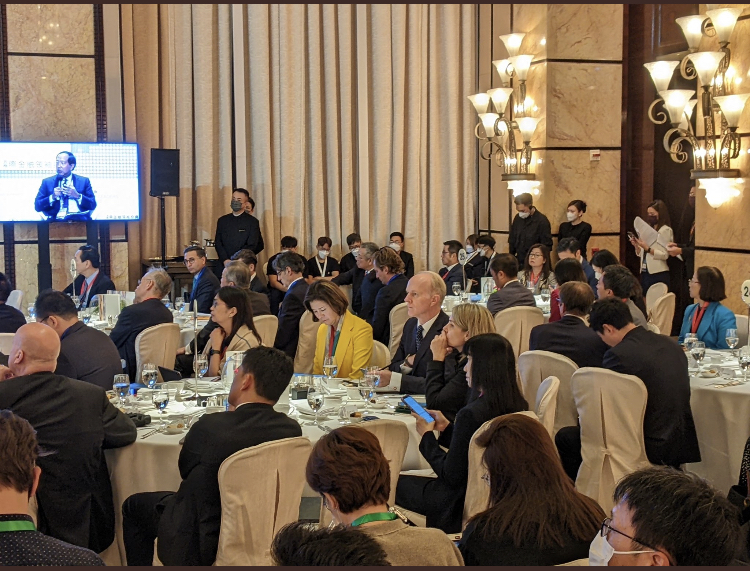Today’s event organisers know that technology can radically transform a run-of-the-mill event into an engaging and unforgettable affair.
The touch of technology is everywhere, particularly behind the scenes at almost all stages of planning and execution of business meetings, events and conferences.
At the upper-end of the technology spectrum, advanced telepresence systems are much touted to be the next best thing to revolutionise the meetings and conferences sector. However, their steep price is out of reach of most small- and medium-scale events.
But companies do not need to go this far and spend a lot of money. There are simple, everyday technologies that could help increase the profile of your event, attract more attendees and add a bit of excitement to an otherwise standard programme.
Think of things you already have at hand – your laptop, mobile phones and PDAs are tools you can use to connect to broader audiences. Using these communication tools enhances your credibility and reputation as an events professional. Prospective delegates appreciate being given timely, relevant event-related information anytime, anywhere.

PRE-EVENT
Hyperlinked Email Signature
Companies hosting an event know that getting the word out early is crucial to their event’s success.
However, before you go sourcing for an email delivery provider to distribute your EDMs (electronic direct mails), consider what you can do to the most overlooked promotion tool on your desktop – your email signature. Add an attention-grabbing call to action at the bottom of your signature and provide your event website link to encourage click-throughs.
This hyperlinked email signature could lead to a microsite hosted in your corporate website, where visitors can download an online registration form and get more information about your event. Be aware, though, that a number of companies are now using an email security system with capability to check embedded hyperlinks on email content. Your email messages maybe labelled as malicious because of the signature hyperlink and are filtered out by the recipient’s system, in which case your effort of putting the hyperlink is wasted. But that’s an exception to the rule.
FTP Storage and Delivery
If the company has no website, then creating a FTP (File Transfer Protocol) server may work just as well. A FTP server can host all your documents, both text and multimedia, which are accessible through the internet. It allows your delegates to upload, download, rename, edit and delete files from the server.
Creating a FTP server is simple, but the event organiser may need tech support to set it up. But once it’s done, it is easy to generate a FTP name, login name and password.
All you need is a laptop or desktop running on Windows XP Professional or more advanced Windows releases (Windows Home edition does not support it) that support FTP. If you are worried about giving third-party access to sensitive information in your server, Windows allows you to create rules that prohibit access to classified files or documents.
Web-Based FTP
If you don’t want to set up a FTP server, you can always choose to send the documents individually as email attachments. Since most emails allow you to attach files only up to a certain size, you may want to use Yousendit (www.yousendit.com), a web-based file transfer programme that allows users to send, receive and track files on demand. Files downloaded onto the Yousendit server can be accessed for one week before the system automatically removes them from the server. You can send files of up to 2GB in one go. Yousendit requires registration and references, but you won’t hesitate to share this software programme with your colleagues and business partners as it is highly reliable and, more importantly, it’s free.
Bulk Texting
SMS is a handy and inexpensive way to send promotional alerts about an event, but how do you send text messages to thousands of recipients and track them at the same time? Officebuddies (www.myofficebuddies.com) allows you to send SMS messages to anyone in over 180 countries in one go using a standard web browser. The service is prepaid and you can buy credits for as low as US$15 for 250 SMS messages or US$260 for 5,000 messages. You can add your own user ID to a message so recipients can text back if they want.
You can use bulk texting to send alerts before, during or after your event.
EVENT PROPER
Corporate event organisers and meeting planners don’t have to invest a fortune to increase their online presence. Take advantage of the so-called Web 2.0 technologies such as blogs, wikis and viral videos to name a few. These technologies allow for self-produced content that can be posted online.
These are considered very cool indeed and, when done with a lot of vigour, can really build the buzz of an event or conference.
Viral Video
Creating a viral video for your event is not rocket science. All you need are a digital video camera, a video editor such as Windows Movie Maker – a standard feature in most Windows operating systems – and a YouTube (www.youtube.com) account.
You can create a viral video by combining video clips, text and graphics, and uploading it onto YouTube to generate a link, which you can then share via email or blog. You may need a video converter if you are creating a new video from existing clips with varying formats. This software will enable you to convert video files into .WMV files that you need to create your new viral video. Search Google for a variety of freeware to select a video converter you can download.
Resist the temptation to send the video as an email attachment because you just don’t know what sort of video playback programmes your recipient is using. Note also that some offices are disabling media players and banning YouTube access for security reasons, so there is no guarantee that viral video links sent to a corporate email will be viewed.
Blogs
The Blogosphere is often seen as a tool for publishing random thoughts and opinion in an unrestricted, no-holds-barred medium. Viewed as uncharted territory, it has nevertheless surprisingly evolved as a publicity tool.
To promote your event in the blogosphere, register with any blog-hosting service, such as Blogger (www.blogger.com) or Livejournal (www.livejournal.com). Blog hosting services are monitored and may take down entries that overtly promote products and events, but you can always find creative ways of drawing attention to the event without a sales pitch.
Voice over IP (VOIP)
Mobility or anytime, anywhere web connection is allowing companies to allow remote delegates to join conferences or business events they might have to miss.
Skype, the revolutionary Voice over IP (VoIP) service originally designed as a low-cost alternative to IDD, can now be used as a platform to connect people from remote locations to a meeting room via laptop and overhead projectors. The recent release of Skype software includes video that makes it possible for conference participants to share files. All you need are a broadband connection, high-resolution video camera and microphone. Be prepared for patchy service as echoes and dropped calls are commonly experienced by Skype users connecting to and from low-bandwidth locations.
The Basic Skype service is free, but if you have extra budget and wants to provide a high-quality telecommunications connection to your remote delegates, then use a web conferencing system by established providers like WebEx (www.webex.com).
One useful feature of a Webex system allows a meeting to be recorded, which an event organiser can then edit as webinar (web seminar) or podcast that can be downloaded online.
Whiteboarding
Glance (www.glance.net) is perfect for event organisers who simply want to give remote attendees a clear view of power point or other presentation format as it is being shown live on a projector or LCD screen in the session hall or meeting room. Glance does not integrate any additional function besides screen sharing and it makes it extremely easy for anyone to use. Sessions can be started in one click.

Virtual World Collaboration
There are fun but unconventional, untested web-based collaboration tools you can consider to add spice to your event. Online virtual community Second Life (SL) at www.secondlife.com offers free downloadable software that allows people to interact with each other through so-called motional avatars, which will serve as your alter ego in the virtual community. SL “residents” communicate using text-based messaging on the SL chat screen and newer versions have voice capabilities.
If one of your speakers cannot be physically present in your event, he can log in to SL, address your audience and conduct Q&A from an SL virtual meeting room. You access that page and display it on an overhead projector. SL software is free but if you want the capability to create your own meeting room with appropriate branding and graphics, you may have to buy SL “currency” called Linden Dollars using your credit card and use the credits to buy graphics from virtual stores on SL.
Online Annotation
Another fun, free and less intimidating presentation tool is Twiddla! (www.twiddla.com), a browser-based whiteboard programme that allows users to remotely share documents and multimedia presentations to unlimited number of participants. Twiddla! supports annotation – participants from any location can share and edit graphics and multimedia files real time using an easy-to-use graphics editing tool. Or you can use the screen to “draw” your presentation real time. To enable whiteboarding, multimedia presentations must be uploaded onto the Twiddla! server, which may raise a red flag for some companies. Uploading time depends on the size of the file and broadband speed, but once the materials are uploaded, presentation will be seamless and smooth.
POST EVENT
Web-based survey
With feedback forms gathered, you may suddenly realise the need for follow ups to know more about your attendees and their requirements, and to get more insights on how to improve future events. Standard feedback forms are difficult to manage and track and they don’t always accurately represent the attendees’ views.
A better option is an online survey such as Survey Monkey (www.surveymonkey.com) which generates granular and customisable feedback form, sends them out through mail, captures and analyses reports that are downloadable in a neat Excel spreadsheet or Word document. Registration is free and you can send as many surveys as you like. Depending on how you formulate your questions, Survey Monkey can even help you capture leads.
Use lucky draws as a hook to drive Survey Monkey responses. Instead of spending money on customary swags, reward respondents with attractive, easy-to-ship gifts such as smartphones.
Meanwhile, a nod to social networking that works best when you want to solicit feedback. Blogs work and so does posting entries on Facebook, Friendster and other social networking media. You may also post video clips of the event on YouTube or share photos by creating an exclusive account at Flickr (www.flickr.com).
Some of these tech tools do have a learning curve, some probably have no time to learn how tools like blogs, wikis and viral videos work. But five to 10 years from now, your event attendees will be today’s children, the Web 2.0 generation who live and breathe technology. It’s worth learning to speak their language now and host events they will be able to relate to. N
INSIDER TALK
Technology is changing the dynamics of how business meetings and corporate events are held. Christina Kautzky speaks with Robert Durand, corporate communications director of US-based LifeSize Communications, on how video-conferencing has affected the industry
CK: Where have you installed HD (high definition) conferencing technology?
We have installed HD conferencing technology in a growing number of conference centres and meeting facilities. Until recently, hotels and conference centres were great at providing meeting space, catering services and event planning – but the nature of modern business demands that conference facilities have top-notch technology, including internet connectivity, display and audiovisual technology, and video communication. Video communication is quickly becoming a hot feature for conference professionals.
CK: What does this help people accomplish? What are the hurdles that this technology automatically overcomes?
Video removes geographic barriers – it allows people to be in two places at once. It removes the time, expense and hassle of travel, and makes it possible to get top talent to participate in events around the globe.
Imagine asking a CEO “can you take a week out of your schedule to deliver a 30-minute address to a local sales team meeting halfway around the world?” Now ask that CEO to make the same address via video without any need to travel and it is much easier for that CEO to agree to participate.
Other hurdles are language and culture. When we see one another, we feel more connected. Seeing one another creates trust and understanding. For building rapport across geographies, video is a great way to let more people meet each other.
CK: If you are holding a regional video conference during a pre-event preparation, is it then easier to plan and coordinate by seeing people as opposed to just hearing them on a call?
Absolutely – event planners know how important it is to cover the details, and when you have people on video, they are far more connected – you see each other, people are paying attention.
Our technology makes it easy to share computer documents, or you can simply point the camera to a whiteboard and brainstorm.
Planning a complex event over email is challenging, and telephone conference calls aren’t very interactive. Unlike a phone call, video makes you pay attention.
Parties to the conference can’t mute their phones and check email or surf the web. With video, business gets done faster and better.
CK: Can you give some examples of ways that LifeSize has been able to fundamentally enhance the experience of an event?
HD video has a wow factor; it really can make an event special. For example, a regional event that ordinarily does not attract international guest speakers can feature people from all over the world – executives, technical experts, product specialists, motivational speakers, educators – and it can turn a mundane event into an extraordinary event. Exploring HD video as a new element of event planning has tremendous potential to differentiate.
CK: What about costs?
Costs are very reasonable, since many facilities already have much of the infrastructure, including broadband internet access, large displays and quality audio systems for their conference rooms. When the cost is viewed in the context of bringing in an executive, with airfare, lodging and expenses, the cost of video is quite reasonable and a tremendous value-add.


